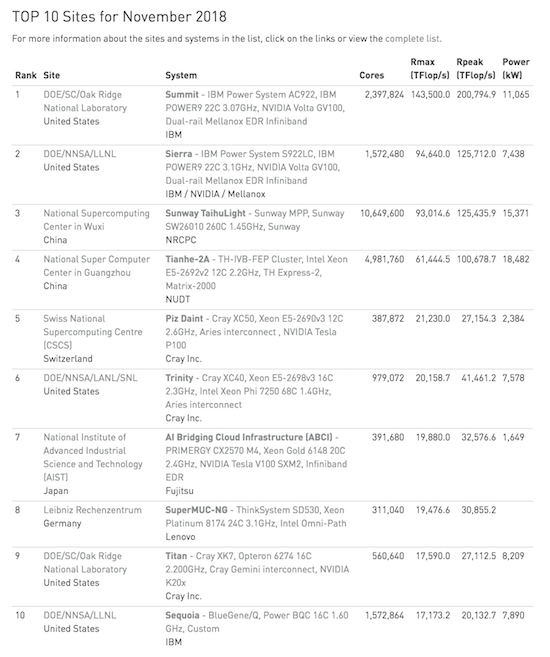In this
podcast, the
Radio Free HPC team looks back on the highlights of SC18 and the newest TOP500 list of the world's fastest supercomputers.
[caption id="attachment_71623" align="alignright" width="300"]
Buddy Bland shows off Summit, the world's fastest supercomputer at ORNL.[/caption]
The latest
TOP500 list of the world's fastest supercomputers is out, a remarkable ranking that shows five Department of Energy supercomputers in the top 10, with the first two captured by
Summit at Oak Ridge and
Sierra at Livermore. With the number one and number two systems on the planet, the "Rebel Alliance" vendors of IBM, Mellanox, and NVIDIA stand far and tall above the others.
Summit widened its lead as the number one system, improving its High Performance Linpack (HPL) performance from 122.3 to 143.5 petaflops since its debut on the previous list in June 2018. Sierra also added to its HPL result from six months ago, going from 71.6 to 94.6 petaflops, enough to bump it from the number three position to number two. Both are IBM-built supercomputers, powered by Power9 CPUs and NVIDIA V100 GPUs.

At number five is Piz Daint, a Cray XC50 system installed at the Swiss National Supercomputing Centre (CSCS) in Lugano, Switzerland. At 21.2 petaflops, it maintains its standing as the most powerful system in Europe. It is powered by a combinations of Intel Xeon processors and NVIDIA Tesla P100 GPUs
Trinity, a Cray XC40 system operated by Los Alamos National Laboratory and Sandia National Laboratories improved its performance to 20.2 petaflops, enough to move it up one position to the number six spot. It uses Intel Xeon Phi processors, the only top ten system to do so.
See our complete coverage of SC18
Sign up for our insideHPC Newsletter
Download the MP3 * Subscribe on iTunes * RSS Feed
